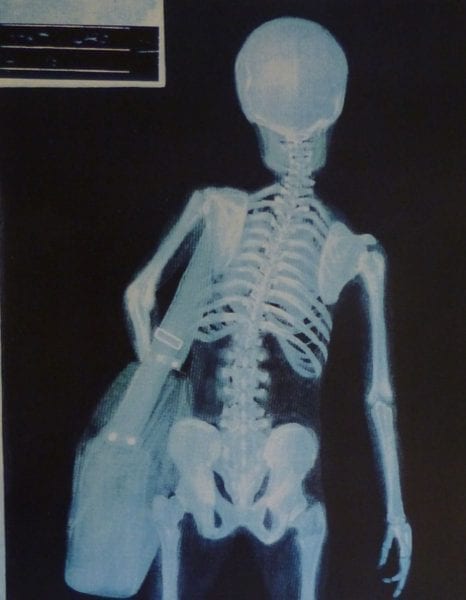By Leena S. Guptha, DO, MBA, BCTMB, PCOM Academic Dean of Graduate Studies
With school back in session, it is no surprise to see students, friends, colleagues, and your kids or grandkids with backpacks stuffed to the brim with binders, books, and supplies. Naturally, as students mature, so will the positioning of the backpack. Enter middle school or high school, and gone are the days of “double strapping” it (i.e. wearing the backpack on both shoulders) and in come the days of slouching the backpack on one shoulder, the “cool” thing. As any manual therapist will be the first to tell you, though, being cool is not always safe, especially in terms of your posture and maintaining musculoskeletal (muscle and bone) health.
The Consequences of Uneven Weight Distribution
Although it might seem trivial, wearing a backpack on only one shoulder or carrying a heavy computer bag on one side of the body, can have serious effects on your shoulder, shoulder girdle, and spine. The fact is, at least 14,000 children are treated for backpack-related injuries every year, according to the U.S. Consumer Product Safety Commission. In this post, we will explore this staggering fact, as well as provide tips to avoid becoming a victim of heavy backpacks and one-sided shoulder bags.
When you do not properly distribute the weight of a bag, either by carrying it on one shoulder or overloading it with weight the following may result:
- Tension of the neck, back, and shoulder muscles, leading to discomfort and/or pain
- Muscle tightness
- Scoliosis of the spine (side-to-side curvature)
- Lower and mid-back pain
- Pelvic tilt
- Asymmetric gait
- Sore hips
- Knee pain
If you think a career in holistic medicine is something you would like to pursue, contact us and speak to an admissions representative to get started on your new journey!
What improper weight distribution means for your body
When carrying a heavy backpack or shoulder bag almost daily, the spinal musculature contracts to compensate for the uneven distribution of weight in an attempt to bio-mechanically rebalance. The spine automatically leans to the other side, increasing pressure on thoracic spine (mid-back) and ribs. This type of imbalance causes muscle strain, muscle spasm, and often tired, achy muscles in the short term. In the long term, especially while a child is growing, improper weight distribution can also exacerbate a scoliosis or lead to a ‘learned’ asymmetry in posture. The heavy weight places a pull on the neck muscles and headache and shoulder pain are commonly reported. Over time, pain and dysfunction can spread throughout the spine and limbs.
Preventative Measures for Safe Backpack and Bag Use
I encourage you to remember the following when carrying a heavy load
- If your bag or backpack has multiple compartments, equally distribute items to further help disperse the weight.
- Use both straps! This will ensure that there is not too much stress on one side of the spine.
- Position your shoulder bag across the body from your non-dominant shoulder.
- For younger children, consider a backpack with a waist strap to further distribute the weight.
- Consider a backpack or computer bag on wheels.
- Pack heavier items closest to the back.
- Choose shoulder bags or backpacks with optimal shoulder and/or back padding for added comfort (and less stress on the muscles).
Be proactive and prevent back pain from backpacks and shoulder bags
- Check in with your child or whoever the backpacker may be to see if they are experiencing any aches or pains after school.
- Help your child/backpacker to choose the right size backpack (often, students go for the biggest and fill it up even more so than needed!).
- Talk to the teachers and faculty about what books really need to be transported on a daily basis.
- Ask if the larger reference books or textbooks are available in the classroom, so your child can keep their copy at home.
- Be an active PTA participant and ensure there are sufficient lockers and time for children to store and exchange books between classes, thereby reducing the total load on the spine.
What to do if you already experience these symptoms
If you, your child or the student already experience any of the above symptoms, talk with your massage therapist during your next session. Your bodyworker will likely be able to relieve ailments such as muscle tightness, lower and mid-back pain, and even help to restore balance to your body. If needed, your therapist will also be able to recommend the proper healthcare professional to discuss further treatment.
Today’s lesson? While it may be the “cool” thing to wear your backpack on one shoulder, your body will appreciate the art of double strapping it!
Tell us! Do you tend to carry your backpack on one shoulder, or use both straps?
Massage therapists! What additional tips do you share with clients when carrying a heavy load?
Leena S. Guptha
DO, MBA, BCTMB
PCOM Academic Dean of Graduate Studies
Past AMTA National President, Past NCBTMB Chair
Featured Posts:

